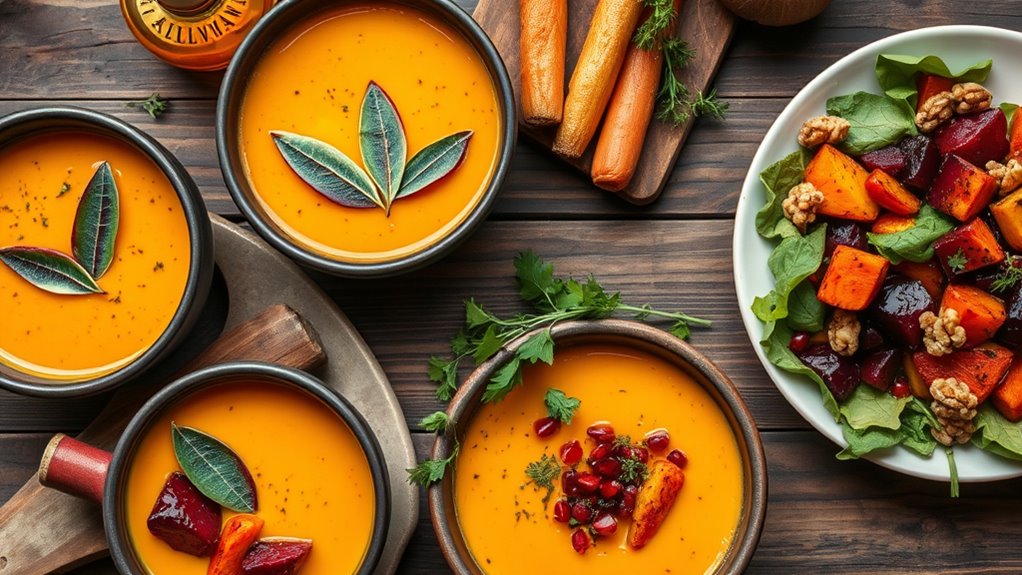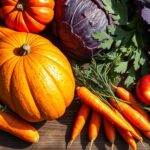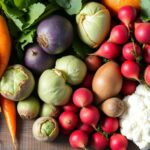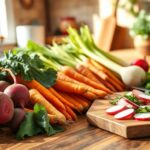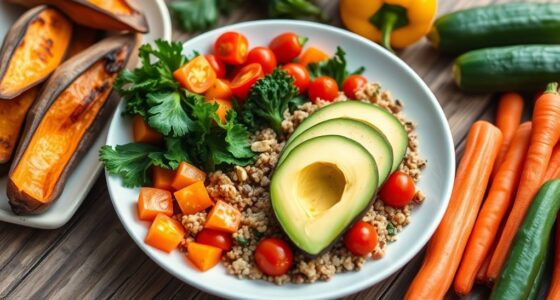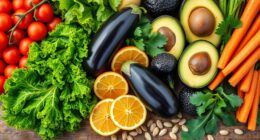Discover delicious seasonal vegetarian recipes perfect for fall and winter by focusing on fresh, local produce from farmers’ markets. Think creamy pumpkin or butternut squash soups, roasted root vegetables, hearty grain bowls, and stews packed with carrots, parsnips, and Brussels sprouts. Using roasting and slow-cooking enhances flavor and richness. Embrace simple, wholesome ingredients that highlight the season’s bounty. Keep exploring for more tips and ideas to make comforting, flavorful plant-based dishes during these cozy months.
Key Takeaways
- Highlight seasonal produce like squash, carrots, root vegetables, and apples for flavorful vegetarian dishes.
- Incorporate comforting soups such as pumpkin or butternut squash, enhanced with cream or coconut milk.
- Roast seasonal vegetables to develop natural sweetness for salads, sides, or soups.
- Use slow-cooking methods to create hearty stews and casseroles with fall and winter vegetables.
- Prepare versatile grain bowls and large batch soups to enjoy the bounty of seasonal ingredients.

Are you looking to make the most of fresh, seasonal produce in your vegetarian meals? Fall and winter bring an abundance of vibrant vegetables and hearty ingredients perfect for creating delicious, comforting dishes. One of the best ways to access peak produce is by visiting farmers’ markets, where you can find farmers’ market finds that embody the flavors of the season. These markets are treasure troves of ripe squash, sweet carrots, earthy root vegetables, and crisp apples—perfect ingredients to elevate your seasonal vegetarian recipes. Shopping directly from local growers not only supports small-scale farmers but also guarantees you’re getting the freshest, most flavorful produce for your meals.
Visit farmers’ markets for fresh, seasonal produce that elevates your vegetarian dishes.
As the temperature drops, cozy soup ideas become especially appealing. There’s nothing quite like a warm bowl of soup to nourish your body and soul during chilly days. Think creamy pumpkin or butternut squash soups, which showcase the season’s best produce. These soups can be made with simple ingredients, simmered to develop rich flavors, and finished with a splash of cream or coconut milk for added smoothness. Incorporate seasonal vegetables like carrots, parsnips, or leeks to deepen the taste and add nutritional value. You can also experiment with hearty lentil or bean soups, providing both comfort and protein to your vegetarian diet. These cozy soups are versatile, easy to prepare in large batches, and perfect for meal prep or sharing with loved ones.
To make the most of farmers’ market finds, consider roasting vegetables like Brussels sprouts, sweet potatoes, or cauliflower to bring out their natural sweetness and add depth to your dishes. Roasted vegetables can be tossed into salads, pasta, or served as side dishes. For a more inventive approach, blend roasted squash into a velvety soup or use it as a filling for savory pies and tarts. Winter vegetables lend themselves well to slow-cooking methods, so don’t hesitate to try stews or casseroles packed with seasonal produce, beans, and fragrant herbs.
In addition to soups and roasted veggies, think about hearty grain bowls topped with roasted vegetables, fresh greens, and tangy dressings. These bowls are not only satisfying but also highlight the best of what the season has to offer. The key is to incorporate as many fresh, seasonal ingredients as possible, making your meals more flavorful and nourishing. With a little creativity, you can turn simple farmers’ market finds into memorable, cozy vegetarian dishes that keep you warm and satisfied all winter long.
Frequently Asked Questions
Can These Recipes Be Adapted for Vegan Diets?
Yes, you can adapt these recipes for vegan diets with some vegan modifications. Swap dairy ingredients with plant-based alternatives like almond milk, coconut yogurt, or vegan cheese. Use tofu, tempeh, or legumes as protein sources instead of eggs or dairy. These plant-based alternatives work well in most recipes, ensuring you still enjoy delicious, seasonal flavors while staying true to your vegan lifestyle.
Are These Recipes Suitable for Meal Prep?
Yes, these recipes are suitable for meal prep. To make the most of your prep sessions, follow some meal prep tips like cooling dishes before storing and using airtight containers. For storage suggestions, keep leftovers in the refrigerator for up to four days or freeze for longer shelf life. This way, you’ll enjoy fresh-tasting meals throughout the week with minimal effort.
How Can I Make These Dishes Gluten-Free?
To make these dishes gluten-free, swap out traditional grains for gluten-free options like quinoa, rice, or buckwheat. Always check labels to prevent cross-contamination, and use dedicated utensils and prep surfaces to avoid cross-contact. Incorporate gluten-free grains into your recipes to guarantee safety and flavor, and be mindful of hidden gluten in sauces or seasoning mixes. This way, you enjoy delicious, safe, vegetarian meals year-round.
What Are Some Tips for Ingredient Substitutions?
Think of ingredient substitutions as your secret recipe for dietary flexibility. To make your dishes seasonal swaps, choose local, fresh produce and experiment with alternative grains or dairy. For example, swap pumpkin for squash or use plant-based milk instead of cream. These small tweaks keep your meals vibrant and adaptable, ensuring you enjoy delicious, personalized dishes all season long. Embrace these tips to turn any recipe into a seasonal, vegetarian masterpiece.
Do These Recipes Include Nutritional Information?
Most of these recipes include nutritional labels with calorie counts and other essential info. You can check the packaging or recipe details to find precise nutritional information. If it’s not provided, you might want to use a nutrition calculator or app to estimate the nutritional content based on the ingredients used. This way, you can easily keep track of your intake and make healthier choices.
Conclusion
Now that you’ve discovered these seasonal vegetarian recipes, you’re all set to embrace the flavors of fall and winter. Think of your kitchen as a cozy fire, warming everyone with hearty, delicious dishes. With these recipes, you can enjoy the vibrant tastes of the season while nourishing your body and soul. So go ahead, get creative, and fill your table with the warmth and comfort of these seasonal delights—your taste buds will thank you!
Ilana has been a vegan for over 10 years. She originally made the switch for health reasons, but soon found herself becoming more and more passionate about the ethical and environmental implications of a vegan lifestyle. Ilana is the author of The Graceful Kitchen, a blog all about veganism. She loves to cook up delicious and nutritious vegan meals, and share her recipes with others who are interested in leading a cruelty-free life. Ilana is also a strong advocate for using whole foods as the foundation of a healthy diet, and believes that going vegan is one of the best ways to achieve this.
